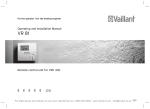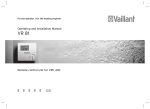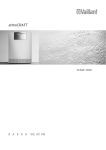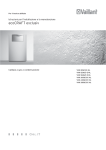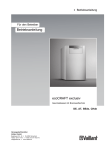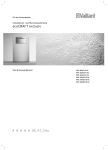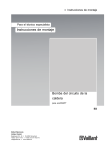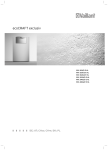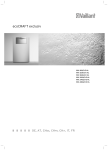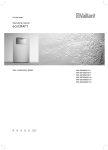Download Vaillant ecoCRAFT VKK GB SERIES Installation manual
Transcript
For the owner Operating manual ecoCRAFT Modular Gas Condensing Boiler GB VKK GB 806/2-E-H VKK GB 1206/2-E-H VKK GB 1606/2-E-H VKK GB 2006/2-E-H VKK GB 2406/2-E-H VKK GB 2806/2-E-H Contents 1 Notes on the documentation Contents 1 1 1.1 1.2 1.3 1.4 Notes on the documentation . . . . . . . . . . . . . Storage of the documents . . . . . . . . . . . . . . . . . . . Symbols used . . . . . . . . . . . . . . . . . . . . . . . . . . . . . . CE label . . . . . . . . . . . . . . . . . . . . . . . . . . . . . . . . . . . Identification plate . . . . . . . . . . . . . . . . . . . . . . . . . . 2 2 2 2 2 2 Safety instructions . . . . . . . . . . . . . . . . . . . . . 3 3 3.1 3.2 3.3 3.4 3.4.1 3.4.2 3.5 Notes on the installation and operation . . . . Intended use . . . . . . . . . . . . . . . . . . . . . . . . . . . . . . . Requirements of the installation site . . . . . . . . . . Care . . . . . . . . . . . . . . . . . . . . . . . . . . . . . . . . . . . . . . Recycling and disposal . . . . . . . . . . . . . . . . . . . . . . Appliance . . . . . . . . . . . . . . . . . . . . . . . . . . . . . . . . . . Packaging . . . . . . . . . . . . . . . . . . . . . . . . . . . . . . . . . Energy saving tips . . . . . . . . . . . . . . . . . . . . . . . . . . 4 4 4 4 4 5 5 5 4 4.1 4.1.1 4.1.2 4.2 4.3 4.4 4.5 6 6 6 6 7 7 8 4.6 Operation . . . . . . . . . . . . . . . . . . . . . . . . . . . . . Checks before start-up . . . . . . . . . . . . . . . . . . . . . . Opening the shut-off valves . . . . . . . . . . . . . . . . . . Checking water level . . . . . . . . . . . . . . . . . . . . . . . . Overview of the operating field. . . . . . . . . . . . . . . Switching the unit on and off . . . . . . . . . . . . . . . . Operator field with multi-function display . . . . . Settings for the heating and hot water operation . . . . . . . . . . . . . . . . . . . . . . . . . . . . . . . . . . Diagnosis mode . . . . . . . . . . . . . . . . . . . . . . . . . . . . 5 5.1 Troubleshooting . . . . . . . . . . . . . . . . . . . . . . . . 11 Resetting a fault . . . . . . . . . . . . . . . . . . . . . . . . . . . . 11 6 6.1 6.2 6.3 6.4 6.5 Care and maintenance . . . . . . . . . . . . . . . . . . Care . . . . . . . . . . . . . . . . . . . . . . . . . . . . . . . . . . . . . . Maintenance . . . . . . . . . . . . . . . . . . . . . . . . . . . . . . . Checking the system pressure . . . . . . . . . . . . . . . . Filling unit/heating installation . . . . . . . . . . . . . . . Measuring and checking work by the chimney sweep . . . . . . . . . . . . . . . . . . . . . . . . . . . . . . . . . . . . . 7 7.1 7.2 10 10 12 12 12 12 12 13 Customer service and warranty . . . . . . . . . . . 13 Vaillant service . . . . . . . . . . . . . . . . . . . . . . . . . . . . . 13 Vaillant warranty . . . . . . . . . . . . . . . . . . . . . . . . . . . 13 Notes on the documentation The following information is intended to help you throughout the entire documentation. Further documents apply in combination with this operating manual. We accept no liability for any damage caused by failure to observe these instructions. Other applicable documents All operating manuals of structural parts and components of the installation must be observed when operating the condensing gas boiler. These operating manuals are included with the individual structural parts of the installation and the ancillary components. 1.1 Storage of the documents Please pass this operating manual on to the owner of the system in order for him or her to store it so that it is available whenever it is required. 1.2 Symbols used Please observe the safety instructions in this operating manual! Danger! Immediate risk of serious injury or death Caution! Potentially dangerous situation for the product and environment. Note! Useful information and instructions • Symbol for a necessary task 1.3 CE label The CE designation documents the fact that the units comply with the basic requirements of the gas equipment directive (Council Directive 90/396/EEC) and the directive concerning the electromagnetic compatibility (Council Directive 89/336/EEC). The appliances meet the basic requirements of the efficiency requirements directive (Council Directive 92/42/EEC). 1.4 Identification plate The identification plate is mounted on the front of the boiler under the front cladding. It becomes visible after the front section of the cladding is removed. 2 Operating manual ecoCRAFT Notes on the documentation 1 Safety instructions 2 Danger! Risk of poisoning and explosion due to a malfunction Never put the safety devices out of operation or tamper with them so as to impair their function. Fig. 1.1 Identification plate 2 Safety instructions What to do in an emergency Danger! If you smell gas, risk of poisoning and explosion due to a malfunction If you smell gas: • Do not switch lights on or off. • Do not use any other electrical switches. • Do not use a telephone in the area of the hazard. • Do not use naked flames, such as matches or cigarette lighters. • Do not smoke. • Close the gas stop cock. • Open the windows and doors. • Warn other residents. • Get out of the house. • Notify your gas supplier or a suitably qualified heating engineer. Safety instructions Always observe the following safety instructions and regulations. Danger! Inflammable mixtures of gas and air may explode Do not use or store explosive or easily flammable substances such as petrol or paint in the same room as the appliance. Operating manual ecoCRAFT Therefore, do not attempt any modifications: - To the appliance - Around the appliance - To the gas, air, water and electricity supply pipes - To the flue pipes - and to the safety valve and the drain pipe for the heating water. This also applies to alterations to structural elements in the vicinity of the appliance which might affect its operational safety. For example: - Keep all openings for air and flue gas free. Make sure, for example, that any temporary covers used when performing work on the outside wall are removed. For alterations to the appliance or to its environment, you must refer to the suitably qualified heating engineer which is responsible for it. Caution! Inappropriate alterations can cause damage Under no circumstances should you ever attempt to make alterations to the gas heating boiler or other parts of the system. Never try to carry out maintenance work or repairs on the appliance yourself. - Do not damage or remove seals on components. Only suitably qualified heating engineer or our customer service may removed sealed components. Caution! Risk of damage! Do not use sprays, solvents, chlorinated cleaning agents, paint, adhesives or similar substances in the vicinity of the appliance. These substances can cause corrosion, including in the flue system. Installation and setting The appliance may only be installed by an suitably qualified heating engineer. This engineer also assumes responsibility for installing the appliance properly and putting it into service for the first time. He is also responsible for inspection, maintenance and repairs to the appliance, and alterations to the set gas volume. 3 2 Safety instructions 3 Notes on the installation and operation Filling pressure of the heating system The filling pressure of the heating installation should be checked at regular intervals. Emergency power supply Your specialist technician connected your gas heating boiler to the electrical mains during installation. If you wish to keep the unit running with an emergency power supply in the event of a power failure, the technical specification of the unit (frequency, voltage, earthing) must be in agreement with the mains power supply, and must be rated to at least the power consumption of your unit. Please consult your heating engineer on this subject. Frost protection If you are going to be away during a cold period, make sure the heating system remains in operation and that the rooms are sufficiently heated. Caution! The frost protection and monitoring devices are only active if the mains switch of the unit is depressed and shows a green light. Addition of frost preventative medium to the heating water is not permitted. Otherwise it could result in damage to seals and diaphragms as well as to noises in the heating operation. Vaillant assumes no liability for this and such consequential damages. Your unit has a frost protection function: If the heating flow temperature falls below 10°C with the main switch turned on, the appliance starts up and heats the entire heating circuit to approx. 20 °C. Caution! Through-flow of the entire heating installation cannot be guaranteed. Another way to protect the heating system and the appliance from frost is to drain them. You must ensure that the system and the appliance are completely drained. Contact your heating engineer. 3 Notes on the installation and operation 3.1 Intended use The Valliant ecoCRAFT units are state-of-the-art appliances which have been constructed in accordance with recognised safety regulations. Nevertheless, there is still a risk of death or serious injury to the user or others or of damage to the device and other property in the event of improper use or use for which it is not intended. The units are intended as heat generators for hot water - central heating installations. Any other use or extended use is considered to be improper. The manufacturer or supplier is not liable for any resulting damage. The user alone bears the risk. Intended use includes the observance of the operating and installation manual and all other applicable documents, as well as adherence to the maintenance and inspection conditions. Caution! Any improper use is forbidden. The appliances must be installed by a heating engineer, who is responsible for adhering to the existing regulations, rules and guidelines. 3.2 Requirements of the installation site The Vaillant gas heating boilers ecoCRAFT must be installed in boiler rooms. Ask your heating engineer which national regulations must be observed. The entire installation site should be frost-proof. Observe the specified frost protection measures in Chapter 2 if you are unable to ensure this requirement. Note! It is not necessary to keep a clearance between the appliance and combustible materials or components, since at the rated heating power of the appliance the temperature at the surface of the housing is always lower than the maximum allowed temperature of 85 °C. When installing the unit, the recommended minimum distances given in the maintenance manual should be observed for reasons of accessibility. 3.3 Care • Clean the exterior of your appliance with a damp cloth and a little soap. Note! Do not use scouring or cleaning agents, which may damage the housing or plastic fittings. 4 Operating manual ecoCRAFT Notes on the installation and operation 3 3.4 Recycling and disposal Both your Valliant ecoCRAFT gas heating boiler and its packaging consist mainly of recyclable raw materials. 3.4.1 Appliance Make sure the old appliance and any accessories are disposed of properly. 3.4.2 Packaging Please leave the disposal of the transport packaging to the qualified servicing company which installed the appliance. Note! Please observe the applicable national legal regulations. 3.5 Energy saving tips Installing a weather compensator Weather compensators regulate the heating supply temperature according to the outside temperature. No more heat is created than is required. The designated heating feed temperature for the corresponding outside temperature must be set on the weather compensator. This setting must not be greater than that required by the design of the heating installation. The correct setting is normally undertaken by the heating engineer. Desired heating and set-back phases (e.g. at night) are automatically turned on and off by using integrated time programs. Weather compensators combined with thermostat valves are the most economical form of heating regulation. Reducing the heating system Reducing the room temperature at night and in your absence. This is best and most reliably realised using regulators with customisable time programs. At such times, set the room temperature approx. 5 °C lower than during full heating times. Reduction of more than 5 °C brings no additional energy saving, because then increased heating capacities would be needed for the next full heating period. Only for longer absences, e.g. holidays, is it worthwhile to further lower the temperatures. However, in winter, make sure that there is adequate frost protection. Room temperature Set the room temperature only as high as would be enough for your comfort level. An extra degree would mean increased energy consumption of about 6%. Adjust the room temperature according to the purpose of use of the room. For example, normally, it is not required that bedrooms or seldom used rooms are heated to 20 °C. Operating manual ecoCRAFT Setting the operating mode In warmer seasons, when the apartment needs no heating, turn the heating to summer mode. The heating mode is then shut off, however, the device or the plant remains ready for operation for water heating. Uniform heating Often, in an apartment with central heating, only one room is heated. Through the encapsulation surfaces of this room, i.e. walls, doors, windows, roofs, floors, the unheated adjoining rooms are also heated in an unregulated manner, i.e. unwanted heat energy is lost. The capacity of the radiator in this one heated room is obviously not enough for such an operating mode. Consequently, the room can not be heated satisfactorily and an uncomfortable feeling of coolness prevails (the same effect is produced when doors between heated or unheated or slightly heated rooms remain open). This is incorrect saving: The heating is in operation and still the room temperature is not comfortably warm. Increased levels of heating comfort and more effective operation are achieved if all rooms in an appartment are heated evenly and in accordance with their utilisation. The building structure can, by the way, also suffer if sections of the building are unheated or only partially heated. Thermostat valves and room thermostat It should be a matter of course, today, that all radiators be fitted with thermostatic valves. They exactly maintain the set room temperature. You can adjust the room temperature to suit your individual requirements and ensure effective operation of your heating installation using the thermostatic valves in combination with a room temperature regulator (weather compensator). In the room where the room temperature regulator is located, all the radiator valves should be fully opened since otherwise the two regulating systems will work against each other and the regulation quality can be affected. The following actions by the user are seen quite often: As soon as the temperature in the room gets too hot the thermostatic valves are turned down (or the room thermostat is set to a reduced temperature). If it gets too cold again after a time, the thermostatic valve is opened up again. This is not necessary since the temperature regulation system takes over this task via the thermostatic valve: If the room temperature rises above the value set on the sensor head, the thermostat valve shuts off automatically, when the temperature drops below the defined value, it opens again. 5 3 Notes on the installation and operation 4 Operation Do not cover regulators Do not cover your regulators with furniture, drapes or similar objects. The room air must circulate unhindered. Covered thermostat valves can be equipped with remote sensors and thus still work. Appropriate hot water temperature The warm water should only be heated up to the extent that is necessary for use. Any further heating results in unnecessary power consumption and hot water temperatures of more than 60 °C also lead to increased lime scale production. Energy-conscious use of water Energy-conscious use of water can reduce your bills considerably. For example, taking a shower instead of a bath: Whereas about 150 litres of water are required for a bath, a modern shower equipped with water saving fittings only requires a third of this water quantity. By the way, a dripping water tap wastes up to 2000 litres of water and a leaking toilet flush up to 4000 litres of water each year. On the other hand, a new seal only costs a few cents. Run circulation pumps only if needed Hot water piped systems are often fitted with so-called circulation pumps. These provide continuous recirculation of hot water in the piping system so that hot water is immediately available, even at drawing-off points which are located far away. These circulation pumps can also be used with the Vaillant ecoCRAFT. There is no doubt that they provide increased comfort for hot water heating. Please bear in mind, however, that these pumps consume electricity. And circulating hot water that is not used cools off when passing through pipes and then needs to be reheated. Therefore, circulation pumps are to be operated only when hot water is actually needed for the household. Individual time programmes can be set using timers which most circulation pumps have fitted to them or with which they can be retro-fitted. Weather compensators often have ancillary functions for controlling circulation pump timings. Ask your heating engineer about this. 4 Operation 4.1 Checks before start-up 4.1.1 Opening the shut-off valves Note! The shut-off valves are not included in the scope of supply of your unit. They are fitted by your heating engineer in the installation. He should show you the location and how to operate these components. 4.1.2 Checking water level • Check the water level (fill pressure) of the installation at the pressure gauge external to the boiler. Your heating engineer has shown you the location of the pressure gauge. It is not integrated into your unit. For the heating system to operate properly, the indicator on the pressure gauge should be at approx. 3 bar when the system is cold. If it is less than 0.8 bar, then water should be added. There is a water pressure switch integrated in the unit which prevents the unit from starting up if the system pressure < 0.2 bar. This is shown in the display as E26. At water pressures > 0.8 bar the fault display disappears. If the heating system extends over several storeys, the system may require a higher filling pressure. Ask your engineer for details. Ventilating residential spaces During the heating period, open windows only for ventilation and not for temperature regulation. A brief impact-ventilation is more effective and energy-saving than windows that are kept open for a long time. We recommend that the windows be opened fully for a short period. During ventilation, close all thermostat valves in the room or set the room regulator to minimum temperature. In this way, there will be adequate ventilation without unnecessary cooling and energy loss (e.g. by the heating switching on during the ventilation procedure). 6 Operating manual ecoCRAFT Operation 4 4.2 Overview of the operating field 4.3 Switching the unit on and off 1 2 3 4 5 6 1 7 8 9 Fig. 4.1 Controls Fig. 4.2 Switching the unit on and off The operating elements have the following functions: 1/2 3 4 5 6 7 8 9 +/- buttons: After the parameters have been called up, the buttons "+" and "-" are used to change the individual values. OK button: All changes must be stored by pushing the OK button. The storing is confirmed by the figures flashing. Information button - i: After calling up the required mode, the individual parameters of the specific mode can be called up by briefly pushing the i-button. Reset button: A malfunction, indicated by a flashing read-out on the display, is reset by pushing the reset button. If the fault reappears, then customer service must be informed. Display for indication of the current operating mode, the menu level or specific additional information Mode button for selection of the various menu levels. Interlock displays for the individual burner modules (fault resolution see Chapter 5.1). Button for switching the unit on and off Caution! The mains switch may only be actuated if the heating installation is properly filled with water. If this is not complied with, damage to the pump and heat exchanger may occur. Use the switch (1) to switch the appliance on and off: When the button (1) is depressed and is lit up, the unit is switched on and has a power supply. When the button (1) is not depressed and is not lit up, the unit is switched off and is isolated from the mains. Caution! The frost protection and monitoring devices are only active if the mains switch of the unit is depressed and shows a green light. In order not to switch off this safety device, you should switch your heating unit on and off using the regulator. Information concerning this will be found in the relevant operating manual. Note! For longer periods out of commission (e.g. for building renovation work) you should turn the gas valve off. In this connection, please refer to the instructions in Chapter 2 concerning frost protection. Operating manual ecoCRAFT 7 4 Operation 4.4 Operator field with multi-function display 1 The following displays occur under normal operating conditions: Operation code 0 1 2 3 4 5 6 7 8 9 Description of functions Standby, no heating function The fan on the relevant module starts up and prevents the burner chamber Ignition is active, the burner ignites The burner burns in heating mode The burner burns in hot water mode The air pressure monitor responds Regulator switch-off of the burner in heating mode Pump overrun, heating pump Pump overrun, charging pump hot water cylinder Regulator switch-off of the burner in hot water mode Table 4.1 Operation codes In the event of a fault, the fault signal flashes alternately with the basic display (see Chapter 5). Fig. 4.3 Display in normal operation The ecoCRAFT units are fitted with a digital information and analysis system. This system provides information on the operating status of your appliance and helps you deal with problems. In the ready for operation mode and in burner operation, the display shows a single figure operating code. This indicates the current operating condition of the boiler and the current temperature at the feed manifold, e.g.: "3 45" = Burner in heating operating mode "3", forward flow temperature "45 °C" Operational displays The operational display provides information on the operational condition of your unit. The operation codes 1, 2 and 5 appear at the start of each individual module. The number of the individual module is preset on the operational display. 8 Operating manual ecoCRAFT Operation 4 Status or fault display Overview of the operating levels Hotwater pre-set Parameter No. Operation mode Parameter No. Setting the maximum temperature Parameter No. Call-ups and settings Setting Factory setting (max.) Min Factory setting may not be changed Boiler feed temperature Display Parameter No. Temp. [°C] Factory setting may not be changed Store set value with “OK” Boiler return temperature Parameter No. Temp. [°C] Parameter No. Overview of parameters 1 to 8 in Chapter 4.6 Fig. 4.4 ecoCraft, overview of the operating levels Operating manual ecoCRAFT 9 4 Operation 4.5 Settings for the heating and hot water operation Virtually all the settings required for the matching of your boiler to the heating installation will have been made in the factory, or will have been matched to your heating installation by your heating engineer. Do not change any of the preset values on the boiler! All time switching and temperature settings for individual matching to the heating system for your requirements can be made using the regulator. Observe the corresponding operating manual when doing this. 4.6 Diagnosis mode In the diagnosis mode, you can have the individual parameters of the boiler displayed. These settings cannot be changed. • Push the mode button twice to activate the diagnosis mode "data". • The following parameters can be called up one after the other by repeated pushing of the i-button: Display Meaning Unit The following settings can be made on the boiler yourself. 1 2 3 4 5 6 7 8 Boiler feed temperature Boiler return temperature No function No function No function Feed temperature target value Preset value fan speed Capacity enquiry, 1 module (40 kW) =100 % e. g. 250 % -> 2.5 x 40 kW = 100 kW °C °C – – – °C r.p.m. % Table 4.2 Parameters in the diagnosis mode Setting the maximum feed temperature Parameter No. Factory setting (max.) 1x Min If a negative value is shown under any of these points, the corresponding sensor is not connected in the boiler. The sensor is either not required for the regulation of your heating installation or it is connected to the heating regulator and can be displayed there. Observe the corresponding operating manual when doing this. Store set value with “OK” Fig. 4.5 Feed temperature setting without heating regulator Setting the maximum feed temperature The maximum feed temperature can be set between 30 and 90 °C in the parameter level under point 3. Caution! None of the other settings in the parameter level can be changed, to avoid malfunctions. 10 Operating manual ecoCRAFT Troubleshooting 5 5 Troubleshooting If the boiler does not start, first check the following points: – Is the gas valve open? – Is the installation fill pressure adequate? – Is the power supply switched on? – Is the main switch turned on? – Is the regulator set correctly? The boiler will then perform a self-test. The basic display appears on the multi-function display after the fault has been resolved successfully. Danger! If the unit still does not start after repeating the fault resolution process three times, then an authorised heating engineer must be consulted to check the unit. If the boiler does not start properly after checking these points, consult an approved heating engineer to check the unit. 5.1 Resetting a fault 1 2 Fig. 5.1 Fault resolution Faults in a boiler module are displayed by the corresponding red module fault resolution button (1) on the operating field. The faults on the boiler can be resolved as follows: • First reset the relevant module by pushing the corresponding red module reset button (1) on the operating field. • Then reset the unit electronics by the RESET button (2) located next to the display. • Repeat the process if the fault is still indicated after the unit has been re-started. Operating manual ecoCRAFT 11 6 Care and maintenance 6 Care and maintenance 6.1 Care Clean the exterior of your appliance with a damp cloth and a little soap. Do not use scouring or cleaning agents, which might damage the housing or plastic fittings. 6.2 Maintenance Each machine needs care and maintenance after a specified operating period to ensure that it will continue to operate safely and reliably. Regular maintenance forms the basis for continuous readiness for operation, reliability and a long working life for your Vaillant ecoCRAFT. A well-maintained heating unit will operate at better effectivity and will therefore be more economical. Permanent operational readiness, safety, reliability and a long service life require inspections and maintenance work to be carried out regularly every year by a heating engineer. Danger! Never attempt to perform maintenance or repairs on your heating unit yourself. Assign an approved qualified servicing company with this work. We recommend signing a service agreement*. The reliability of the appliance can be impaired, resulting in damage to property or personal injury if maintenance work is not carried out. 6.3 Checking the system pressure For the heating system to operate properly, the indicator on the pressure gauge should be at approx. 3 bar when the system is cold. If it is less than 0.8 bar, then water should be added. Pay attention to the water quality and the hardness of the filling water. There is a water pressure switch integrated in the unit which prevents the unit from starting up if the system pressure < 0.2 bar. This is shown in the display as E26. At water pressures > 0.8 bar the fault display disappears. If the heating installation operates over several floors, it may be necessary to have higher water levels on the pressure gauge. Ask your heating engineer about this. 12 6.4 Filling unit/heating installation Caution! ecoCRAFT boilers consist of a heat exchanger made of ALUMINIUM alloy. In order to inhibit the natural corrosion process in a heating or hot water system, the system must be thoroughly flushed out before commissioning. Deposits of lime and the formation of gas in the water can lead to damage in the boiler, and the system must be water-tight to avoid damage The addition of chemicals such as e.g. frost and corrosion prevention materials (inhibitors) is not permitted. Information concerning the filling and topping up of the heating installation can be provided by your approved heating engineer. Proceed as follows to fill the installation: • Open all thermostatic valves in the installation. • Connect the filling and drain cock of the installation to a cold-water tap using a hose. (Your heating engineer should have shown you the filling fittings and should have explained the filling and draining of the installation to you). • Turn the filling cock and the tap on slowly and add water until the required installation pressure is shown on the pressure gauge. • Turn the tap off. • Vent all the radiators. • Re-check the pressure in the installation (if necessary repeat the filling process). • Close the filling cock and remove the filling hose. Operating manual ecoCRAFT Care and maintenance 6 Customer service and warranty 7 6.5 Measuring and checking work by the chimney sweep 1 7 Customer service and warranty 7.1 Vaillant service To ensure efficient and reliable operation of your boiler it is recommended that regular servicing is carried out by your service provider. Vaillant Applied System Sales Vaillant Ltd., Unit D1 Lowfields Business Park, Elland. West Yorkshire. HX5 9DG Training Telephone Fax email 01634 292370 01634 292354 [email protected] Commercial Service Fig. 6.1 Chimney sweep measurements/combustion check The checking aperture is installed separately in the exhaust ducting. When using a Vaillant exhaust gas duct adaptor for Vaillant plastic exhaust systems (accessories), there is an additional facility (1) for checking, at the back, on the right hand side, just above the cladding cover. If a Vaillant VRT heating regulator is connected in, the "chimney sweep operation" should be set there in order to carry out the measurements. If the heating installation is not operated with a regulator that has a "chimney sweep operation" mode, you can set the boiler to maximum output by the use of a combination of buttons. • This is done by pushing down and holding the buttons "Mode" and "+" for five seconds. Note! The test programme is automatically exited after 15 minutes. All burner modules are switched to full load. • The measurements should be taken at the earliest after 2 minutes of operation of the unit. Operating manual ecoCRAFT Telephone Mon - Fri 0870 850 3072 8.30 - 17.30 Fax email 01773 525 946 [email protected] 7.2 Vaillant warranty Vaillant provide a full parts and labour warranty for this appliance. The appliance must be installed by a suitably competent person in accordance with the Gas Safety (Installation and Use) Regulations 1998, and the manufacturer’s instructions. In the UK ‘CORGI’ registered installers undertake the work in compliance with safe and satisfactory standards. All unvented domestic hot water cylinders must be installed by a competent person to the prevailing building regulations at the time of installation (G3). Terms and conditions apply to the warranty, details of which can be found on the warranty registration card included with this appliance. Failure to install and commission this appliance in compliance with the manufacturer’s instructions may invalidate the warranty (this does not affect the customer’s statutory rights). 13 0020029295_00 GB 07 2006
















